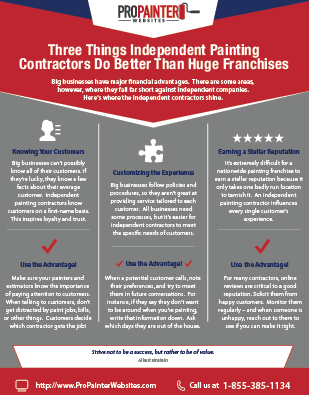Figure Out How Seasonal Factors Affect Commercial External Painting Success And Uncover The Very Best Times To Ensure Enduring Outcomes For Your Job
Figure Out How Seasonal Factors Affect Commercial External Painting Success And Uncover The Very Best Times To Ensure Enduring Outcomes For Your Job
Blog Article
Content Writer-Leach Celik
When you're intending a commercial external painting task, seasonal aspects can make or damage your results. You'll intend to think about just how temperature and moisture effect paint application and drying times. Picking the right period can ensure your paint sticks appropriately and lasts much longer. But which seasons are truly the best for this type of job? Let's discover the key elements that can affect your project's success.
The Effect of Temperature Level on Paint Application
When you're planning a commercial exterior paint job, the temperature level can considerably influence just how well the paint adheres and dries.
Preferably, you intend to paint when temperatures range between 50 ° F and 85 ° F. If it's too cool, the paint may not cure effectively, leading to issues like peeling off or fracturing.
On How to calculate painting price? , if it's as well hot, the paint can dry out too swiftly, protecting against correct attachment and leading to an unequal surface.
You ought to additionally think about the time of day; early morning or late afternoon offers cooler temperatures, which can be much more beneficial.
Constantly examine the supplier's referrals for the specific paint you're using, as they commonly provide support on the suitable temperature range for ideal outcomes.
Moisture and Its Effect on Drying Times
Temperature level isn't the only ecological factor that affects your industrial exterior paint job; moisture plays a substantial role too. High moisture degrees can slow down drying times dramatically, impacting the total top quality of your paint work.
When the air is saturated with wetness, the paint takes longer to cure, which can bring about problems like poor attachment and a higher risk of mold development. If you're repainting on a particularly damp day, be prepared for extensive wait times between coats.
It's vital to keep an eye on regional climate condition and strategy appropriately. Preferably, aim for humidity degrees in between 40% and 70% for optimal drying.
Maintaining these consider mind ensures your project stays on track and supplies a long lasting surface.
Best Seasons for Commercial Outside Painting Projects
What's the very best season for your business exterior painting tasks?
https://commercialpaintersnearme21654.loginblogin.com/42795414/the-comprehensive-handbook-for-working-together-with-paint-service-providers and early loss are generally your best bets. Throughout these periods, temperature levels are light, and moisture degrees are often reduced, creating perfect problems for paint application and drying out.
Avoid summertime's intense heat, which can cause paint to completely dry also promptly, leading to bad attachment and finish. In a similar way, winter months's cool temperature levels can hinder correct drying out and healing, running the risk of the longevity of your paint work.
Go for days with temperature levels in between 50 ° F and 85 ° F for optimum outcomes. Keep in mind to check the neighborhood weather prediction for rain, as damp conditions can spoil your job.
Planning around these variables ensures your painting task runs smoothly and lasts much longer.
Final thought
In conclusion, planning your industrial outside painting tasks around seasonal factors to consider can make a substantial difference in the result. By organizing work throughout the ideal temperatures and moisture levels, you'll ensure much better bond and drying times. Remember to watch on regional weather forecasts and select the right time of year-- springtime and very early loss are your best options. Taking these steps will certainly help you achieve a resilient and professional surface that lasts.
